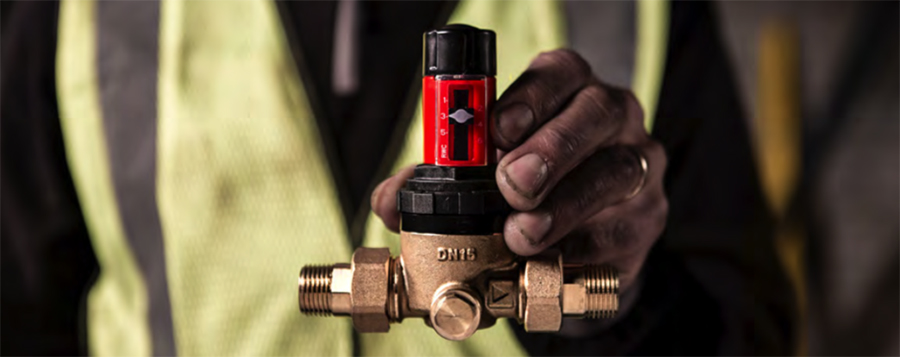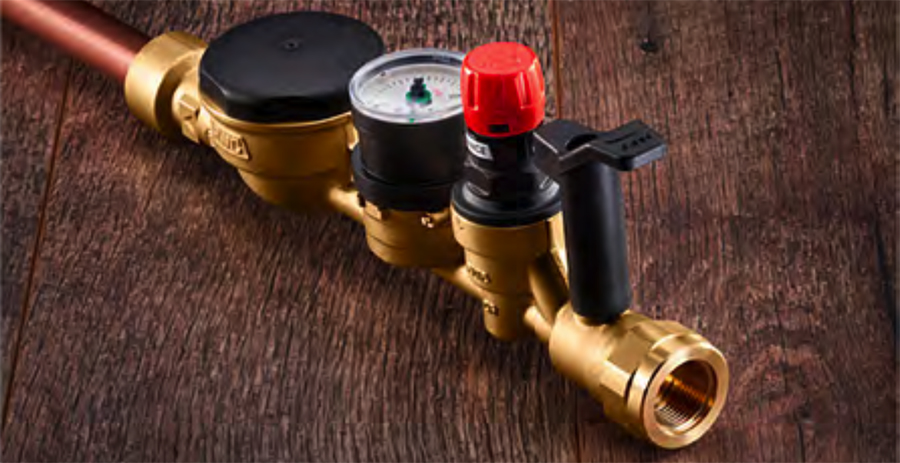All you need to know about TMVs, PRVs and the Tenant Valve
Contents |
[edit] Do not get your ABCs confused
The specification process is an essential part of the life cycle of any plumbing system. It is important that specifiers are knowledgeable on not only what valves are required, but their key benefits and reasons for installation. The key plumbing valves – the TMV, PRV and Tenant Valve each have their own crucial role to play.
Depending on the application, there are many complexities and factors to take into account when specifying the valves for a plumbing system in both domestic and commercial new builds. Specifiers must consider the unique demands of each building, which will vary widely depending on type of building, in addition to regulatory requirements that vary by product and application, as well as end user needs and maintenance.
In times of skyrocketing energy prices and cost of living expenses, not to mention the ambitious net zero targets from the Government for the building industry, everything that goes into the fabric of our buildings counts to ensure our buildings are as energy efficient and economical in the long-term as possible. From the smallest fitting to every pipe and the most essential valve, what goes on behind the walls is just as important as the brickwork our future is built on. In this feature, we discuss the benefits and common uses of the most important valves, making it as straight-forward as possible for specifiers to identify what variation of each valve to use, where and when.
[edit] Thermostatic Mixing Valve
Whether a homeowner or landlord or a local council, building owners have a duty of care for those living, working, or using their facilities, which is why thermostatic mixing valves (TMV) play a crucial role in all plumbing systems. It is imperative that some form of TMV be specified for every hot water system. The main benefit of a TMV is keeping water at a safe temperature, which therefore prevents scalding and helps stop the build-up of harmful Legionella bacteria. This is achieved by mixing hot and cold-water streams together to ensure a safe temperature at the outlet.
The type of TMV required for an individual application will vary greatly on what kind of building the specification is taking place in, as domestic and commercial buildings have a different requirement to buildings in the healthcare sector.
It is recommended that in domestic and commercial environments, a TMV2 approved valve is specified, and safely installed, tested and maintained to current standards. These valves are designed to reduce the risk of scalding at outlets, while minimising the potential build-up of Legionella bacteria in the pipework that is fed from the outlet side of the valve to the tap. They are typically found under sinks and basins, and never more than 2m away from the outlet they are serving. For buildings occupied by the healthcare sector, such as hospitals, a TMV3 needs to be specified, which functions the same way as a TMV2, but undergoes more rigorous testing, both at the point of installation, as well as every six months after initial sign- off. This is to ensure the safety of the end users, who are likely to be more vulnerable to both scalding and the potential harmful infection from Legionella bacteria.
Where a TMV2 can typically only work with water pressures of 5 bar or below, a TMV3 is safe to work with 10 bars of water pressure.
[edit] Pressure Reducing Valve
A pressure reducing valve (PRV) functions, as the name suggests, by reducing a high inlet pressure at the inlet to a safer, lower water pressure at the outlet. The benefits of PRVs are multiple, as lower water pressures can decrease the amount of damage to heating systems, appliances, and buildings. Considering water pressure in the UK can vary from 1 bar to 20 bar, it is important that any risk to plumbing and heating systems is minimised to keep buildings and people safe.
As there are no regulations on water pressure in the UK there are no regulations for specifying PRVs, however, to reduce risk of unsafe water pressure it is highly recommended to specify them not only for domestic buildings, but especially for commercial buildings, where it is not uncommon to have sudden jumps in water pressure. PRVs ensure that the flow rate of water is not only correct for its intended purpose but that there is a safe water pressure that will allow other valves, such as thermostatic mixing valves, to function correctly as well. The individual valve that should be specified will depend heavily on the type of building, the water flow rate, and whether or not it is being used on a hot or cold-water supply.
[edit] Tenant Valve
The most innovative valve in recent years is the Tenant Valve Plus from Reliance Valves, a specialist combination valve that is designed for use in large multiple-occupancy buildings, such as apartment complexes and high-rises. The Tenant Valve Plus combines an approved stop cock, a pressure reducing valve, inline strainer, water meter carrier and backflow prevention device into a single and compact unit for large domestic buildings, where having a central, adjustable plumbing hub is much more desirable.
Additionally, this allows for each residence to have individual control depending on their requirements, whilst mitigating the need for installing inlet valve chains. Inlet valve chains often take up a lot of room in riser cupboards or service hatches, which also makes them difficult to adjust or maintain. Having a long chain of valves also means many more leak points than the Tenant Valve’s single piece design. All components are accessible from one side of the Tenant Valve, which is supplied with a moulded insulating cover. For use up to 16 bar and 85°C and adjustable between 1.5 – 6.0 bar, the Tenant Valve is suitable for almost all UK multi-occupancy buildings.
[edit] All valves in one place
Valves are some of the most important components in a plumbing and heating system, and specifying the right valve for the right application and usage, can have a huge and lasting impact on the life cycle of each system and the building it is in. When specifying valves for a plumbing and heating system you want to be sure that the valve is perfect for the intended purpose.
The above article includes an extract of "Do not get your ABCs confused – all you need to know about TMVs, PRVs and the Tenant Valve" published in the AT journal, issue 144, Winter and written by Richard Bateman, Product Marketing Manager, RWC.
--CIAT
[edit] Related articles on Designing Buildings
- A guide to installing thermostatic mixing valves: what, why and how.
- Domestic hot water.
- Mechanical, electrical and plumbing MEP.
- Ofwat.
- Pipework defects, ventilation and airflow rates.
- Pipework.
- Pressure independent control valves.
- Pressure-relief valve.
- Pumps and dewatering equipment.
- Radiator.
- Tap.
- Thermostatic mixing valve.
- Types of valve.
- Types of water.
- Valve.
- Water safety plan WSP
- Water.
Featured articles and news
Infrastructure that connect the physical and digital domains.
Harnessing robotics and AI in challenging environments
The key to nuclear decommissioning and fusion engineering.
BSRIA announces Lisa Ashworth as new CEO
Tasked with furthering BSRIA’s impressive growth ambitions.
Public buildings get half a million energy efficiency boost
£557 million to switch to cleaner heating and save on energy.
CIOB launches pre-election manifesto
Outlining potential future policies for the next government.
Grenfell Tower Inquiry announcement
Phase 2 hearings come to a close and the final report due in September.
Progress from Parts L, F and O: A whitepaper, one year on.
A replicated study to understand the opinion of practitioners.
ECA announces new president 2024
Electrical engineer and business leader Stuart Smith.
A distinct type of countryside that should be celebrated.
Should Part O be extended to existing buildings?
EAC brands heatwave adaptation a missed opportunity.
Definition of Statutory in workplace and facilities management
Established by IWFM, BESA, CIBSE and BSRIA.
Tackling the transition from traditional heating systems
59% lack the necessary information and confidence to switch.
The general election and the construction industry
As PM, Rishi Sunak announces July 4 date for an election.
Eco apprenticeships continue help grow green workforce
A year after being recognised at the King's coronation.
Permitted development rights for agricultural buildings
The changes coming into effect as of May 21, 2024.


























Comments
[edit] To make a comment about this article, click 'Add a comment' above. Separate your comments from any existing comments by inserting a horizontal line.